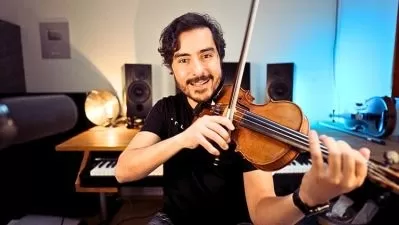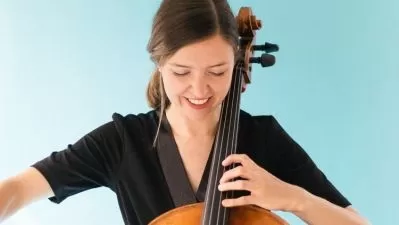Creative Violin/Viola/Cello: Improvise on a Groove!
Gustavo Strauß
58:05
Description
Everyone can improvise! Here’s a step-by-step course on how to play exemplarily over an easy D minor loop
What You'll Learn?
- Learn how to play freely on a groove and chords!
- Learn how to use scales
- Learn how to use phrases as base for your improvisation
- Learn how to use any point in a rhythmic structure to start phrase and gain indefinite variations for your phrases
- Learn how to find, vary and develop a motif
Who is this for?
What You Need to Know?
More details
DescriptionAre you a string player just wanting to start improvising and get an idea of what you can do when you hear a nice chord structure with a catchy rhythm? This is what I will teach you in this course!
In this course, we will dive into joyful improvisation with the help of an easy D minor loop.
First, we'll learn to free ourselves and just play. Then, we'll look at which notes fit the chords and learn the scale.
Next, we'll practice using these notes and getting accustomed to them so we can truly "play" with them. Once we've achieved that, we can start working with melodies through a few exercises.
To incorporate the rhythmic element into our improvisation, we'll explore the topic of phrasing—how to play phrases, where to place them, and how to create a good rhythmic structure with a clear beginning and end.
Finally, we'll focus on the topic of "motif"—how to develop, vary, and use it to create a beautiful improvisation!
All this knowledge can then be applied to any other song, chord structure, or solo.
All lessons are designed with play-along and follow-along sections. The sheet music for the chord structure is in the download section in the G clef, Alto clef, and Bass clef. The long version of the loop can also be downloaded.
Who this course is for:
- Violinists of all levels who a re curious to expand their knowledge and skillset in new directions
- Violists of all levels who a re curious to expand their knowledge and skillset in new directions
- Cellists of all levels who a re curious to expand their knowledge and skillset in new directions
Are you a string player just wanting to start improvising and get an idea of what you can do when you hear a nice chord structure with a catchy rhythm? This is what I will teach you in this course!
In this course, we will dive into joyful improvisation with the help of an easy D minor loop.
First, we'll learn to free ourselves and just play. Then, we'll look at which notes fit the chords and learn the scale.
Next, we'll practice using these notes and getting accustomed to them so we can truly "play" with them. Once we've achieved that, we can start working with melodies through a few exercises.
To incorporate the rhythmic element into our improvisation, we'll explore the topic of phrasing—how to play phrases, where to place them, and how to create a good rhythmic structure with a clear beginning and end.
Finally, we'll focus on the topic of "motif"—how to develop, vary, and use it to create a beautiful improvisation!
All this knowledge can then be applied to any other song, chord structure, or solo.
All lessons are designed with play-along and follow-along sections. The sheet music for the chord structure is in the download section in the G clef, Alto clef, and Bass clef. The long version of the loop can also be downloaded.
Who this course is for:
- Violinists of all levels who a re curious to expand their knowledge and skillset in new directions
- Violists of all levels who a re curious to expand their knowledge and skillset in new directions
- Cellists of all levels who a re curious to expand their knowledge and skillset in new directions
User Reviews
Rating
Gustavo Strauß
Instructor's Courses
Udemy
View courses Udemy- language english
- Training sessions 12
- duration 58:05
- Release Date 2024/08/12









